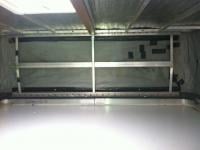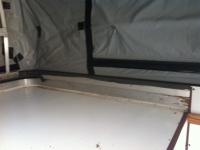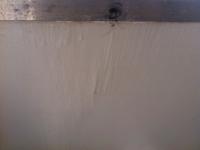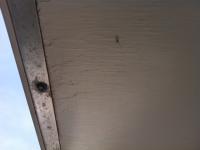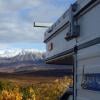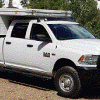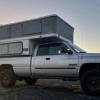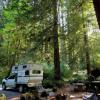Hey Guys,
I recently purchased a 2000 Grandby Shell model from a guy here in Ontario. I'd been searching for months and everything I found was either on the West coast or wayyyy out of my price range. Then, on April 15th, a member by the name of Lingenstein posted a Kijiji ad over on the alert thread and that was it. I emailed the poster right away and called him that night to make arrangements for when I could pickup my new camper.
He told me over the phone that there had been some water damage near the front right corner (passenger side) from the previous owner installing a roof rack incorrectly. He said the rack had been removed and the holes filled with silicone, but the lift mechanism had to be replaced, so he used a square aluminum frame design that he fabricated himself. Of course, I was skeptical, but when I saw it for myself, it was actually pretty neat. He used the original springs and everything, and just used sheet metal screws to secure them to the aluminum frame. I actually quite like the new design as you can easily clean the vinyl at the front of the camper where before it would have been impossible with the original lift mechanism. He removed all the insulation in the roof because he said it was damaged from the water, so now there's basically no roof, which I don't really mind because I'll probably need to run some more wires for lights and possibly solar panels (if I ever get there).
While performing my due diligence, I noticed the white paint underneath the cabover was cracking just a little along the trim. He assured me it was just residual damage and it was nothing to be concerned about. The price was right and it was only about a 3 hour drive from my house, so I went ahead and bought it. Last weekend, I gave it a real thorough cleaning and noticed 4 inch paneling on the passenger side cabover was wet, and not just a little bit wet, but really wet! My curisotiy got the better of me and I ended up ripping all the way back to where the cabover starts. I got looking at the floor of the cabover and it now looks like there's about a 6 inch area that is wet and soft.
So my question is this... What do I do now? Do I leave it and wait for it to get worse? Can I patch just that one small section? Do I pull the entire thing out and replace it? If so, how difficult is it? Is that whole front cabover just plywood or are there some kind of aluminum supports up there? Just not really sure which way to turn. You guys have been a great source of knowledge so far and I look forward to hearing your suggestions.
Cheers,
Dylan




